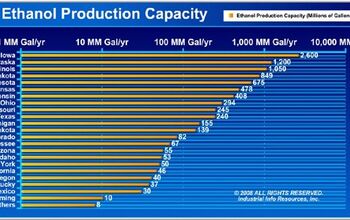E85 Boondoggle Of The Day: Corn Ethanol Justified By POETic License
The EPA’s goal of encouraging production of 100m gallons per year (gpy) of cellulosic (i.e. non-corn-based) took a bit of a hit recently, when it was found that the firm responsible for producing 70m gpy was actually showing investors petroleum-based fuels and lying about its production capacity. Whoops! But instead of drawing the conclusion that ethanol is the modern equivalent of snake oil, attracting hucksters and scams like mainstream car blogs to a special-edition Mustang, the government is keeping the sector well-stocked with taxpayer cash. Green Car Congress reports that the Department of Energy has awarded ethanol firm POET a $6.85m increase over its already-delivered $76m grant, with another $13.15m on the way. The funds were awarded through Project LIBERTY (Launch of an Integrated Bio-refinery with Eco-sustainable and Renewable Technologies in Y2009), which seeks to move ethanol past the tortilla riot-era bad press while keeping it chained to big agribusiness. The method? Ethanol from corn cobs!
POET’s Project LIBERTY plants are attached to existing corn-ethanol plants, and none of them have actually entered standard production, probably because ethanol futures are in the toilet. Meanwhile, the only study on the impact of removing cobs from fields (where they are usually left as a nutrient source) was undertaken by the University of Iowa “for POET.” Shockingly it showed “no substantial impact on soil nutrient levels.” Ethanol boosters will doubtless try to point out that cob-based ethanol is “better” than straight corn juice, and obviously the impact on food prices is diminished. Still, there are numerous potential feedstocks for cellulosic ethanol, and the fact that POET chose corn cobs is indicative of the importance of ethanol subsidies to agribusiness. By integrating cellulosic plants into the corn-based ethanol infrastructure, Project LIBERTY provides a “just around the corner” cover for the corn ethanol industry, while sucking down taxpayer money for the privilege. Meanwhile, even if corn cobs become a viable source of ethanol, demand for the biofuel has been tanking, as its many downsides have sunk into the consumer consciousness.
More by Edward Niedermeyer
Latest Car Reviews
Read moreLatest Product Reviews
Read moreRecent Comments
- SCE to AUX I see a new Murano to replace the low-volume Murano, and a new trim level for the Rogue. Yawn.
- BlackEldo Why even offer a Murano? They have the Rogue and the Pathfinder. What differentiates the Murano? Fleet sales?
- Jalop1991 Nissan is Readying a Slew of New Products to Boost Sales and ProfitabilitySo they're moving to lawn and garden equipment?
- Yuda I'd love to see what Hennessy does with this one GAWD
- Lorenzo I just noticed the 1954 Ford Customline V8 has the same exterior dimensions, but better legroom, shoulder room, hip room, a V8 engine, and a trunk lid. It sold, with Fordomatic, for $21,500, inflation adjusted.


































Comments
Join the conversation
@ rnc Thanks for introducing hemp into the discussion. People often aren't aware that there are sans-THC versions of the hemp plant. Much to the disappointment of pot-heads and ultra-conservatives who need some reason for a reaction. Hemp paper and fibres are much more environmentally friendly, especially when compared to cotton. Cotton crops consume something like fully 1/3 of all pesticides used in the world, plus huge amounts of water. Here in Australia we have a strong commercial hemp industry going, which of course is hoping to get the jump into ethanol. You can't beat plants for energy storage, but the real breakthrough needs to be heavy use of cellulosic processes commercially. Algae, waste conversion, plus plenty of research going into cellulosic methanol. Anything that accelerates these achievements should be welcomed. Corn use (as feedstock) will drop away soon enough.
I'll be completely satisfied to use ethanol when the primary feedstock is the dandelions from my yard.